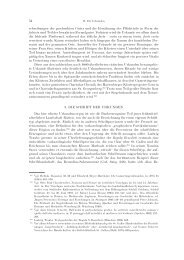Chapter Three ANTHOLOGIES AND ANTHOLOGISTS Between c ...
Chapter Three ANTHOLOGIES AND ANTHOLOGISTS Between c ...
Chapter Three ANTHOLOGIES AND ANTHOLOGISTS Between c ...
You also want an ePaper? Increase the reach of your titles
YUMPU automatically turns print PDFs into web optimized ePapers that Google loves.
128<br />
Part One: Texts and Contexts<br />
recurrent festive occasions, most poems in the Anthologia Barberina were composed<br />
for a one-off event. Is the purpose of AB “antiquarian”? In various<br />
scholarly publications Constantine VII is praised for, or accused of, his alleged<br />
“antiquarianism” – which is rather an unlucky catch phrase to denote the<br />
various cultural phenomena of his long reign. The Anthologia Barberina is<br />
perhaps “antiquarian” inasmuch as it contains many poems that were composed<br />
for a specific moment in the past. But it is equally “modern”, as it<br />
provides models to be imitated for future occasions, such as the epithalamium<br />
on Leo VI (AB 36), which was re-used and adapted some twenty years later for<br />
the wedding of Constantine VII and Helen Lekapene (AB 39). More importantly,<br />
however, an anthology containing a large amount of poems in accentual<br />
metres is really without precedent in the ninth and early tenth centuries. It is<br />
precisely for this reason that the Anthologia Barberina should be viewed as a<br />
novelty rather than as a supposedly “antiquarian” enterprise. Seen from the<br />
viewpoint of tenth-century Byzantium, the Anthologia Barberina opens up new<br />
perspectives on the recent, but somehow ever distant past.




